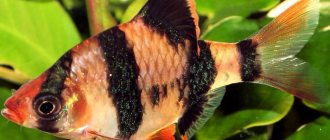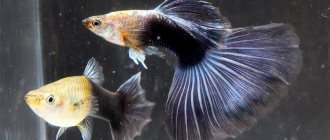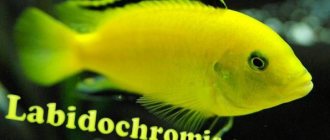Depending on the species, determining the sex of a fish ranges from easy to nearly impossible. Knowing the sex differences of aquarium fish is important when breeding fish, as well as for choosing the right balance of fish in a community aquarium. Although not all fish can be easily identified by sex, these tips will help you recognize the sex of many common aquarium fish species.
Here's how to determine the sex of common aquarium fish. This is by no means an exhaustive list, but it gives a general overview of the differences between the sexes of fish.
Head and jaw shape
The male pink salmon has a rather aggressive and menacing appearance. If you see a fish with an uneven head shape, a crooked jaw and protruding sharp teeth, then it is a male. Be sure to look into the pink salmon's mouth. The teeth of males look crooked and have different lengths.
The female's head has a more even shape. Females are distinguished by a rounded jaw without protruding teeth. They look less predatory than males. Their teeth are the same length.
Pink salmon with damage and tears in the upper part of the jaw are sometimes found on sale. Unscrupulous sellers break the male's jawbone to make his head straight and pass him off as a female.
How to determine gender differences in aquarium fish?
One of the important questions when buying fish is about gender differences. First-time aquarists tend to buy a pair of each desired species. However, it is difficult to recognize among young fish which ones are males and which ones are females. This difference in fish appears quite late. Many of the fry look like females of this species; male characteristics appear when they reach sexual maturity. There are exceptions where females acquire additional coloration when reaching sexual maturity, but this is not the case in most species. Therefore, you should buy several fish, not a couple. With a larger number of them, the probability increases that among the fry there will be representatives of both sexes, who will later form pairs.
Aquarists buy fish according to their tastes. This means that color and shape play a big role when choosing. When purchasing fish of many species, hobbyists often limit themselves to only males, since they have more beautiful colors and larger fins. Aquariums pop up with only male guppies, and many don’t even think about adding females to them. As a result, such males become aggressive - they injure and maim each other, so that nothing remains of the original beauty.
In other species, the following is observed: only one male is always visible, the rest, due to his dominance, hide in shelters. Males of some species must be kept together in large numbers in order for them to display bright colors during competition, which would never be possible when keeping one pair. If good living conditions are provided and proper feeding is provided, the behavior of fish (mating games and reproduction) will be normal, without any deviations.
There are other reasons for creating conditions for fish that are as close to natural as possible. The appearance of the aquarium deteriorates not only because of the fight between the males, but also because the females of some species of fish, when well fed, spawn in the absence of males. In this case, their appearance suffers and they are no longer a decoration for the aquarium.
How are males and females recognized? Let's look at fish in groups that have similar characteristics.
The easiest way to determine sex is in viviparous carp-toothed animals. In males, the anal fin is sharp; with its help, sperm packets are delivered to the female's genital tract. The anal fin of the female has rounded contours. The fry before puberty have fins like the females and are therefore difficult to distinguish. In half-developed fry, you can notice how the fins develop: future males have smaller fins than those of females. As soon as the fin rays begin to grow, the sex of the fish can be clearly determined.
The sexual characteristics of cyprinids can be determined by their body structure, since males are smaller and have a flatter abdomen. In most cases, males are brighter than females. The same applies to characoids. Small males with a flat belly are easy to distinguish from females. Interestingly, males of those species that have a developed instinct for caring for offspring and protecting territory are usually larger than females.
Most catfish are difficult to distinguish by gender. Since sexual maturity is reached quite late, in large catfish after several years, the throwing of eggs by the female is the simplest and most accurate sign of gender. In species that do not care for offspring, females are larger.
The gender of labyrinth fish is easily determined. Males are more intensely colored, their unpaired fins are elongated and pointed.
Most cichlid fish are characterized by the same characteristics of sex, but it is not possible to form a pair artificially. Caring for offspring requires the consent of partners. This means that couples must find each other themselves and get used to it for a while. Glassfish are easy to identify. The blue border on the dorsal and anal fins indicates the development of the male before his orange-red color appears.
In Bedotia, male coloration takes longer to develop. There are no longer any characteristics that can be used to distinguish males from females, so it is necessary to purchase a large group of young fish.
The color of rainbow fish depends on the time of day. The most beautiful coloring appears during morning mating displays, during the day they fade, the coloring may appear again in the evening hours. An adult male can be identified by its large first dorsal fin. The female's first dorsal fin barely reaches the second.
All males are brighter than the females, which are typically gray-brown to yellow.
Among the Badis, the males are black and blue, the females remain brown. At the young age at which the fish are sold, males can be distinguished by their sunken belly.
Half-snouts are viviparous fish. As with viviparous cyprinodonts, males are recognized by a modified first ray of the anal fin, while females have a normal fin structure.
Male gobies have enlarged first dorsal fins, often with a larger fin surface.
These characteristics are guidelines and are not the exact sexual characteristics of each species. Pisces cannot evaluate their partner until puberty. So, young females and males can fight each other. Only after reaching maturity do they transmit signals of what gender they are during wrestling. Interestingly, when recognizing sex, many species rely more on behavior than on color and body structure.
Eyes and nose
A predatory expression in the eyes and a hook-shaped nose are characteristic of males. Females have a less aggressive appearance. They have no curvature in the nose.
Rosstandart: “Every tenth gas station deceives.” How to protect yourself from underfilling
All medical prescriptions in Russia will become electronic and replace paper ones
Like a rug: Jane decorated an old concrete porch with a stencil and paint
Carp
Barbs and other representatives of the carp family are quite difficult to distinguish from each other. Differences will vary depending on the species, but in general, males are more intensely colored and slimmer than females. Since most cyprinids are schooling fish, one way to get a breeding pair is to buy a group of them. In some cyprinid species, including goldfish, males develop small white bumps (nuptial tubercles) on the head, operculum, and possibly on the spine of the pectoral fins during mating season. Males will chase a female who lays eggs, and the males will fertilize them as she lays them. After breeding, the eggs are usually not cared for and the parents may even eat them if found.
Abdomen
First of all, inspect the abdomen for damage. Often sellers and fishermen make a small puncture or incision in this part to remove the eggs.
A symbol of the sun, goodness and immortality: why are “skates” needed on the roof of a Russian hut
What to do to prevent lipstick from imprinting on the mask: use powder
A giant “flying saucer” hovered over Bulgaria (photo)
If you are convinced of the integrity of the carcass, then look at the fish from the front. In pink salmon with caviar, the abdomen looks thickened and compacted. Try pressing it lightly. If you feel a homogeneous compaction with a jelly consistency, then this is caviar. If pink salmon was caught during spawning, then when pressure is applied to the abdomen, eggs may come out of it.
Angelfish
Angelfish are extremely difficult to determine exactly what gender they are, especially when they are young. Sometimes fully mature males develop a small nuchal protuberance, which is a bump on the head just above the eyes. However, don't expect it to be present in every case. The best way to create a pair is to buy half a dozen immature angelfish and raise them together. When they are mature enough they will split into pairs and you should have at least one breeding pair from the group. Once they start mating, it will be very obvious which one is male and which one is female, since she will be the one who will lay the eggs with the ovipositor. The ovipositor is a short tube extending from the female's opening that she uses to lay eggs. Has a rounded tip. The male will use a pointed tube that extends from his opening to fertilize the eggs after the female has laid them. Both parents will take turns hovering over the eggs, fanning them with their fins to oxygenate them and keep them clean.
Tetras
Tetras have some differences between the sexes, which vary depending on the species. Females are slightly larger and plumper than males. Males are often more brightly colored and may have longer fins than their female counterparts. Tetras are schooling fish, so pairings can be obtained by simply purchasing a small school of them at a time. They usually reproduce as males, chasing the female and fertilizing the eggs when she lays them on plants or scatters them among rocks. There is no parental care for the eggs; if a fish finds them, they will eat them.
How to distinguish female pink salmon with eggs
Not every female is caught with red caviar. Let's continue the search for pink salmon with the coveted caviar.
Select more females from the counter. Now each one needs to be inspected and felt:
- The first step is to inspect the fish carcass for possible damage. Take a special look at the abdomen. Often, you come across neatly pierced females with gutted bellies. Inspect all the smallest damage to the fish.
- Look for a female with a hard belly where a lump can be felt. It feels like there will be something jelly-like inside the fish, homogeneous and not related to the fillet part of the carcass.
- Next, examine the tail part of the female, the so-called exit hole. Choose the fish with the brightest pink and widest opening.
Sex reassignment process
Getting to know the life of fish is surprising: how can they adapt to the conditions of their living space? And their fantastic sex change tricks are simply shocking. Not all species resort to such metamorphoses, but the list of those who can do this is quite wide and numbers about 350 species. These include the wrasse, photos of which can be found on the Internet.
All wrasses are protogynous hermaphrodites. This is when all males become females as they age. The mystery of this fantastic transformation could not be solved for many decades.
With the advent of new genetic research techniques, scientists have discovered when and how specific genes are turned on and off during sex changes. This study is important because it provides insight into how the environment can influence genetic processes.
What influences gender change:
- Environment. When the temperature changes upward, the already hatched fry turn from females into males. If the eggs are matured at elevated temperatures, more males will appear. All this is due to the effect of the enzyme on sex hormones. As the temperature rises, male hormones are formed more actively. Changing the light has the same effect.
- Social conditions. The social group of wrasses determines the presence of harems. Experienced stress—disturbances in the state of the colony, flock or group, or habitat—promotes sex change. In the event of the death of the dominant male in the group, the oldest and largest fish capable of reincarnation becomes a male. She needs about ten days for all this. In a matter of minutes her behavior changes, in a matter of hours her color changes, in a matter of days her ovaries transform, and after 10 days she is already producing sperm.
- Age is when over the years between 6 and 14 years the female can change her sex.
Today, there is an opinion among scientists that all these reasons are not the main ones in fish changing sex. There are still unexplored mechanisms, work to identify which is underway.
Nuances you need to know
It would seem that the given characteristics are quite sufficient to unambiguously establish the sex of a particular individual. In reality, these differences are quite difficult to notice, especially for inexperienced aquarists. The situation is further complicated by the fact that Danios are very mobile fish, so examining them is very problematic . In addition, certain nuances should be taken into account:
Beginners are recommended to purchase several Danios so that they immediately form a school, and it is better to buy adult fish. If you plan to breed them, it is important to initially understand the sexual composition of the flock.











